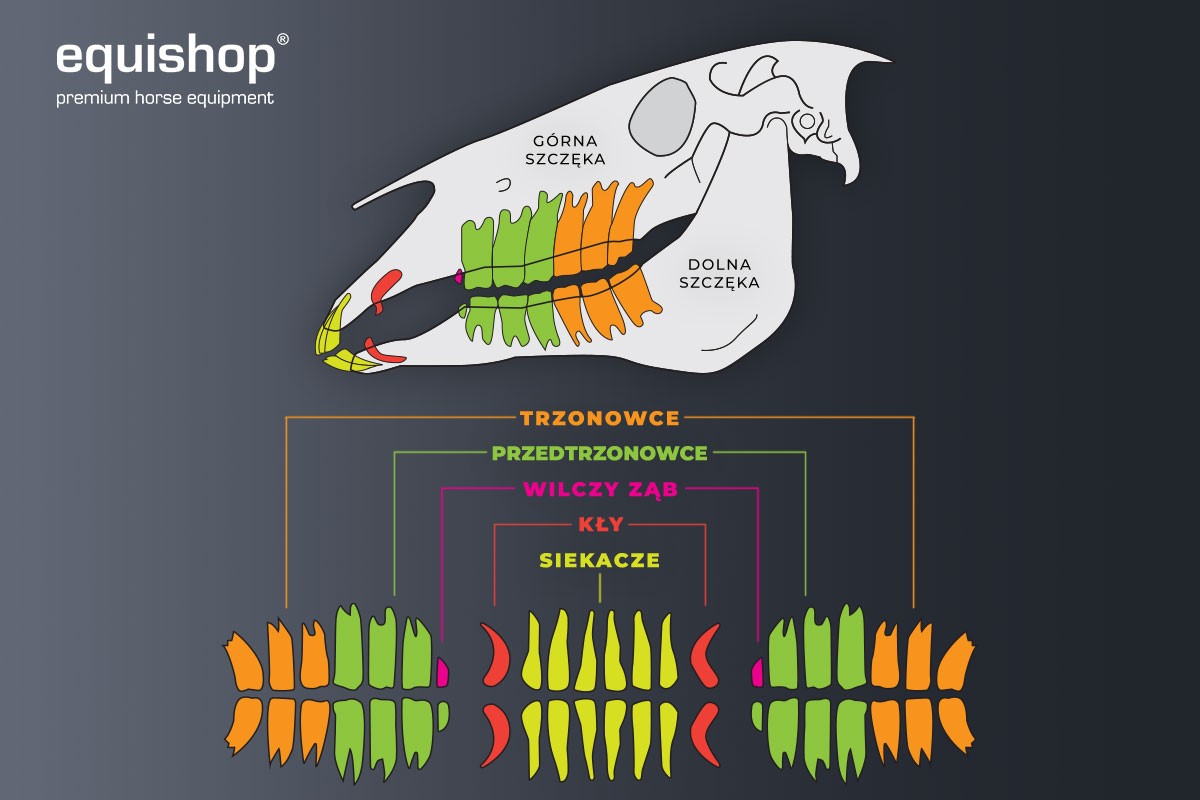
Zaglądając do jamy ustnej konia możemy uzyskać wiele informacji na jego temat, m.in. jaki jest jego wiek czy stan zdrowia.
Należy regularnie sprawdzać stan uzębienia naszych koni, by mieć pewność, że wilcze zęby nie przeszkadzają mu w żuciu wędzidła czy ostre krawędzie zębów nie ranią podniebienia w czasie jedzenia czy jazdy.
Wygląd zębów, a wiek konia

Każdy lekarz weterynarii, zootechnik czy bardziej doświadczony jeździec są w stanie stwierdzić w jakim mniej więcej wieku jest koń, oglądając jedynie jego przednie zęby.
Konie w ciągu życia stale wymieniają liczbę zębów, a także ich wygląd - wraz z wiekiem zęby mleczne zamieniają się w stałe, a one z biegiem czasu ścierają się i zmieniają kształt.
Na co zwrócić uwagę?
Końskie zęby tak naprawdę rosną przez całe życie, ale również naturalnie się ścierają. Tempo ich ścierania to około 2 mm na rok.
Wiek zwierzęcia oceniamy na podstawie kąta nachylenia zębów, a także na podstawie koron siekaczy i rejestrów. Jeżeli koń jest pomiędzy 2, a 5 rokiem życia, to można dość dokładnie określić jego wiek obserwując dane partie zębów, które wymieniają się w odpowiedniej kolejności.
Jeżeli dokładnie zaobserwujesz korony siekaczy, to dostrzeżesz wyrastające z biegiem czasu warstwy zęba. Większa ilość warstw wskazuje na wiek konia.
Jednym z najważniejszych wyznaczników końskiego wieku są rejestry, czyli wgłębienia w zębach. To właśnie one ulegają spłyceniu - im mniejsze wgłębienie tym starszy jest koń.
Rejestry obserwujemy w zębach stałych, jest to około 6 mm na dolnej szczęce i 12 mm na górnej szczęce. Rejestry całkowicie ścierają się w wieku 11-13 lat i potem coraz ciężej jest określić wiek konia.

Źrebaki w wieku 2 miesięcy mają już wyrżnięte mleczne zęby (tzw. mleczne cęgi), które wymieniane są na zęby stałe między 2, a 3 rokiem życia.
Zdarza się, że u koni starszych występują zęby mleczne, wtedy zalecana jest wizyta dentysty.
Zęby mleczne są łatwe do rozpoznania - mają one kieliszkowaty kształt, a kolor jest wyraźnie biały, podczas gdy zęby stałe są wydłużone i bardziej żółte.
Wymiana uzębienia zaczyna się od wymiany zębów siecznych (około 2,5 r.ż.), następnie wymieniane są cęgi (około 3,5 r.ż.), a na końcu wymieniane są okrajki.
Pięcioletni koń ma już pełne uzębienie stałe.
Wgłębienia w stałych zębach (rejestry) stają się coraz mniej zauważalne. Wgłębiania są całkowicie zatarte na siekaczach znajdujących się na żuchwie, górne siekacze mają wciąż zauważalne niewielkie wgłębienie. Z biegiem czasu i stałym tarciem zęby zaczynają stawać się trójkątne.
Rejestry we wszystkich zębach są zatarte, zarówno na górnej szczęce, jak i dolnej.
Stan uzębienia wciąż się zmienia, a kształt zębów u koni z trójkątnych zmienia się na owalno-podłużny.
Jakie są najczęstsze problemy z uzębieniem u koni?
Konie nie zawsze pokazują dyskomfort, dlatego łatwo jest przeoczyć niepokojące objawy, które mogłyby wskazywać na nieodpowiedni stan zębów i ból.
Mimo wszystko, możesz zauważyć pewne objawy, które mogą zaalarmować o wystąpieniu choroby przyzębia lub innych, poważnych schorzeń.
Jeżeli zauważyłeś, że u Twojego konia występuje jakiś z poniższych objawów, to koniecznie wezwij lekarza weterynarii/końskiego dentystę, który dokładnie obejrzy wnętrze jamy ustnej konia:
problem z przyjęciem wędzidła/niechęć do założenia wędzidła,
wyciąganie języka podczas jazdy,
niedojedzone jedzenie w żłobie/niechęć do przyjęcia pokarmu,
kawałki niestrawionego jedzenia w odchodach,
nagły spadek masy ciała,
zauważalne napięcie żuchwy,
niechęć do ruchu na przód,
apatia/obwisłe uszy.
Jeżeli zauważyłeś powyższe objawy, to powinieneś skonsultować je w lekarzem weterynarii, który potwierdzi ewentualne wystąpienie choroby.
Kluczowe znaczenie mają regularnie wizyty dentysty (co najmniej raz w roku, najlepiej co 6-9 miesięcy), który wykryje problem, nawet w momencie, kiedy koń nie wykazuje żadnych oznak bólowych.
Jakie problemy z uzębieniem możemy najczęściej spotkać?
Wilczy ząb - wilcze zęby nie pojawiają się u każdego konia, jednak jeżeli je zauważysz, należy niezwłocznie wezwać dentystę, w celu usunięcia ich. Wilcze zęby najczęściej występują na żuchwie (dolnym łuku zębowym) i znajdują się tuż przed przedtrzonowcami, czyli w miejscu wędzidła.
Haki - haki są konsekwencją wady zgryzu, przy której końskie zęby ścierają się nierównomiernie. Jest to problem związany z zębami policzkowymi, które przez problem wysunięcia (górnych lub dolnych) zębów do przodu nie ścierają się w całości.
Zęby mleczne - zdarza się, że zęby mleczne nie wypadną, a w ich miejscu wyrastają zęby stałe. Powoduje to sytuację, że mleczak jest uciskany pomiędzy zębami powodując ogromny ból i dyskomfort. W takiej sytuacji często wymagana jest operacja.
Ostre krawędzie zębów - występują u niemalże wszystkich koni i wymagają tarnikowania (wyszlifowania). Zewnętrzne części zębów, które znajdują się w części szczęki (górnych zębów) często nie są równomiernie zatarte, przez to, że szczęka jest nieco szersza od żuchwy. Ostre krawędzie powodują ból i dyskomfort, a także ranią policzki i język konia.
Ropienie - treść ropna, która pojawia się wokół korzenia zęba, jest niezwykle boląca oraz niebezpieczna dla konia i wymaga niezwłocznej operacji. Ropa obejmuje najczęściej okolice zębów trzonowych i przedtrzonowych.
Kły - kły występują u ogierów i mogą stać się ostre, często powodując ból. Należy je regularnie kontrolować i tarnikować (szlifować).
Jeżeli podczas wizyty weterynaryjnej dowiesz się, że Twój koń ma pewną wadę zgryzu, to powinieneś co pół roku kontrolować, ponieważ jest on narażony na częstsze występowanie schorzeń związanych z zębami.
Parę ciekawostek
U dorosłego ogiera jesteśmy w stanie doliczyć się 40 zębów, a u klaczy tylko 36! Dlaczego? U ogierów występuje 12 siekaczy, 24 trzonowce (zęby trzonowe i przedtrzonowe) oraz 4 kły, natomiast kły w jamie ustnej klaczy nie występują.
W miejscu wędzidła nie ma zębów! Wędzidło leży w części pyska konia, w której znajdują się jedynie dziąsła, tuż za siekaczami, a przed przedtrzonowcami.
Końskie zęby zajmują więcej miejsca niż mózg konia.
Źrebięta mają jedynie 24 zęby mleczne.
Przednie zęby konia nazywają się siekaczami, ponieważ służą one do przycinania i skubania trawy.
Zadbane i zdrowe zęby są bardzo ważne, jednak nie należy zapominać o odpowiedniej pielęgnacji włosia czy kopyt konia. Zajrzyj do działu Pielęgnacja konia i zaopatrz się w najlepsze produkty pielęgnacyjne.
Aktualności ze sklepu jeździeckiego Equishop:








